Air of Authority - A History of RAF Organisation
No 712 - 825 Squadron Histories
Numbers in the 700/800 series were allocated to flights (700 series only) and squadrons of the Fleet Air Arm of the RAF, when the 400 series flights of the FAA were amalgamated into squadrons from 1933 onwards. When the control of the FAA was handed over to the Admiralty this series of squadron numbers was also taken over and no RAF squadrons have been allocated numbers in this block since. The histories in this section only cover the period of service up to the handover of the FAA to the Admiralty. The award of badges to these Fleet Air Arm was laid down in Admiralty Fleet Order No 1205, dated 14th May, 1936.
The flight formed on 15 July 1936 from the aircraft allocated to ships of the 1st Battle Squadron serving with the Home and Mediterranean Fleets. It was equipped with a variety of types including Ospreys, Fairey IIIFs, Sharks, Seals and Swordfishes and operated from HM Ships Barham, Malaya, Valiant, Hood, Royal Oak and Warspite, its shore base in the Mediterranean being Calafrana in Malta.
The Flight was transferred to Admiralty control on 24 May 1939.
The flight formed on 15 July 1936 from the aircraft allocated to ships of the 2nd Battle Squadron in the Home Fleet. It initially operated the Walrus, and later the Seal and Swordfish, from HM Ships Nelson, Ramilles, Resolution, Rodney and Royal Oak, its shore stations being Mount Batten until 1938, when it changed to Lee-on-Solent.
The Flight was transferred to Admiralty control on 24 May 1939.
The flight formed on 15 July 1936 from the aircraft allocated to ships of the Battle Cruiser Squadron of the Mediterranean Fleet. It operated the Shark and Swordfish from HM Ships Repulse and Renown, its shore base being Calafrana.
The Flight was transferred to Admiralty control on 24 May 1939.
The flight formed on 15 July 1936 from the aircraft allocated to ships of the 1st Cruiser Squadron of the Mediterranean Fleet. It initially operated the Osprey and later the Walrus from HM Ships London, Devonshire, Shropshire and Sussex, its shore base being Calafrana, Malta.
The Flight was transferred to Admiralty control on 24 May 1939.
The squadron formed between July 1936 and July 1937 by the raising of No 712 (Catapult) Flight to Squadron status. The squadron was equipped with Osprey seaplanes and these where allocated to ships of the 2nd Cruiser Squadron.
Initially the squadron operated the aircraft on board HMS's Leander, Neptune and Orion and when not at sea their base was Mount Batten. When the Ospreys were replaced by Walrus' the squadron operated from HMS's Newcastle, Glasgow, Sheffield and Southampton and its shore base was Lee-on-Solent. HMS Cornwall was added in January 1938 but it was replaced by HMS Cumberland in March 1939.
The Squadron was transferred to Admiralty control on 24 May 1939.
[Aircraft & Markings | Commanding Officers]
The flight formed on 15 July 1936 from the aircraft allocated to ships of the 3rd Cruiser Squadron of the Mediterranean Fleet. It initially operated the Osprey and later Seafox from HM Ships Arethusa, Galatea and Penelope, its shore base being Calafrana, Malta.
The Flight was transferred to Admiralty control on 24 May 1939.
The flight formed on 15 July 1936 from the aircraft allocated to ships of the 4th Cruiser Squadron on the East Indies Station, equipped with Fairey IIIF from HM Ships Emerald, Enterprise, Gloucester, Liverpool, Manchester and Norfolk, its shore base being Seletar with detachments operating from China Bay in 1938-1939.
The Flight was transferred to Admiralty control on 24 May 1939.
The squadron formed on 15 July 1936 from the aircraft allocated to ships of the 5th Cruiser Squadron on the China Station, and was equipped with Osprey seaplanes.
Initially the squadron operated the aircraft on board HMS's Berwick, Dorsetshire and Kent and when not at sea their base was Kai Tak. In September 1936, HMS Kent left to be replaced by HMS Birmingham with HMS Cornwall, HMS Cumberland and HMS Suffolk being added later.
The Squadron was transferred to Admiralty control on 24 May 1939.
[Aircraft & Markings | Commanding Officers]
The flight formed on 15 July 1936 from the aircraft allocated to ships of the 6th Cruiser Squadron in the South Africa Station. It initially operated the Osprey and later Seafox from HM Ships Amphion and Neptune, its shore bases being Mount Batten (1936), Simonstown (1936 - 1939) and Lee-on-Solent (1938)
The Flight was transferred to Admiralty control on 24 May 1939.
The squadron formed on 15 July 1936 from the aircraft allocated to ships of the 8th Cruiser Squadron on the Americas and West Indies Station. The squadron was equipped with Fairey IIIF and Osprey seaplanes and operated the aircraft on board HMSs Apollo, Ajax, Exeter and York, when not at sea their base was Bermuda. Walrus' replaced the Faireys in late 1936 and the Ospreys were replaced by Seafoxes in 1937.
The Squadron was transferred to Admiralty control on 24 May 1939.
[Aircraft & Markings | Commanding Officers]
The flight formed on 15 July 1936 from the aircraft allocated to ships of the New Zealand Division. It operated the Walrus from HM Ships Achilles and Leander, its shore bases being Mount Batten (1936) and Auckland (from 1 June 1937).
The Flight was transferred to Admiralty control on 24 May 1939.
The announcement of the formation of the above units was containing in Air Ministry Order A160/36 dated 2 July 1936 as follows:-
This paragraph gave the date of formation, title of unit and naval formations to which each unit was allocated as shown above.
It is essential to the new organisation that the RAF organisation of the aircraft should be coincident with the naval organisation of HM ships. Consequently when a ship is transferred from one naval formation to another, the transfer of the aircraft, personnel and maintenance stores to the appropriate flight or squadron will be carried out automatically and without further instructions from the Air Ministry. (e.g. If HMS "Neptune" is transferred from 2nd Cruiser Squadron to 3rd Cruiser Squadron the aircraft carried in the ship will be transferred automatically from No 712 (Catapult) Squadron to No 713 (Catapult) Flight. All vouchers, inventories, etc, held by the RAF Station, Mount Batten, or by Coastal Command will be transferred immediately to the RAF Station, Calafrana, or to the Mediterranean Command as appropriate. The Mediterranean Command will assume all administrative and maintenance responsibilities, and all returns from HMS "Neptune" will be forwarded to the Admiral Commanding 3rd Cruiser Squadron or to the RAF Base, Calafrana, or to Mediterranean Command Headquarters, as appropriate)
When a ship belonging to a foreign station returns to home waters for any purpose and is not transferred or attached to a naval squadron in home waters, the aircraft and personnel will be regarded as detached from their flight or squadron to the RAF Station Mount Batten, or to the RAF Station, Lee-on-Solent, as ordered by the AOC, Coastal Command. The AOC, Coastal Command (through the RAF Station concerned) will assume full administrative and maintenance responsibility whilst the ship remains in home waters or whilst the aircraft remain shore based. All returns and reports will be made to the RAF station concerned or to the Coastal Command, as appropriate.
In the event of a naval squadron being transferred from one command to another (e.g., from Home Fleet to Mediterranean Fleet) the whole RAF flight or squadron concerned will be automatically transferred to the appropriate RAF command.
Formed on 3 April 1933 by amalgamating No's 402 and 404 (Fleet Fighter) Flights. The squadron was equipped with nine Nimrods and three Ospreys and served aboard HMS Courageous in the Home Fleet. In 1935-1936, the carrier and the squadron operated in the Mediterranean during the Abyssinian crisis. The squadron re-equipped with the Skua in October 1938 and took these aboard HMS Ark Royal.
The Squadron was transferred to Admiralty control on 24 May 1939.
[Aircraft & Markings | Commanding Officers]
Formed on 3 April 1933 by raising No 401(Fleet Fighter) Flight to squadron status, equipped with three Flycatchers and six Nimrods aboard HMS Furious. The carrier and squadron operated in both home and Mediterranean waters. Ospreys replaced the Flycatchers in 1934 and Nimrods left in 1936. Skuas and Sea Gladiators arrived in 1939 and at this time the squadron was earmarked as a deck landing training unit aboard HMS Courageous, but the hand over of the FAA to the Admiralty prevented this as the squadron was immediately reclassified as a second line unit and re-numbered No 769.
[Aircraft & Markings | Commanding Officers]
Formed on 3 April 1933 by amalgamating No's 408 and 409 (Fleet Fighter) Flights. The squadron was equipped with nine Nimrods and three Ospreys and served aboard HMS Glorious in the Mediterranean fleet. The squadron returned to the UK in 1934 when Glorious was refitted. In the meantime the squadron served aboard HMS Courageous, but rejoined Glorious in the Mediterranean in August 1935. Sea Gladiators arrived in May 1939 but the squadron was transferred to Admiralty control on 24 May 1939.
[Aircraft & Markings | Commanding Officers]
Formed on 3 April 1933 at Netheravon by raising No 405 (Fleet Fighter) Flight to squadron status with nine Ospreys. The same month the squadron embarked aboard HMS Eagle and set sail for the Far East. The squadron moved to HMS Hermes in January 1935, still in the Far East, but on 1 October 1937, it disbanded. A new 803 Squadron formed at Worthy Down on 21 November 1938 from 'B' Flight of No 800 Squadron. Initially equipped with six Ospreys and three Nimrods, the Ospreys were replaced the following moth by Skuas. In April the squadron embarked on HMS Ark Royal but its further service in the RAF was short-lived as the Squadron was transferred to Admiralty control on 24 May 1939.
[Aircraft & Markings | Commanding Officers]
Formed on 3 April 1933 by amalgamating No's 463 and 44 (Fleet Torpedo Bomber) Flights equipped with 12 Darts. The following month the squadron embarked aboard HMS Courageous as part of the Home Fleet. Ripons replaced half of the Darts in September 1933 and the first Baffins arrived in July 1934. By November the squadron was wholly equipped with the Baffin. From August 1935 to February 1936, HMS Courageous and 810 Squadron moved to the Mediterranean during the Abyssinian crisis. Sharks replaced the Baffins in April 1937 and Swordfish were received the following September. The squadron transferred to HMS Ark Royal in October 1938, embarking in January. The Squadron was transferred to Admiralty control on 24 May 1939.
[Aircraft & Markings | Commanding Officers]
Formed on 3 April 1933 by amalgamating No's 465 and 466 (Fleet Torpedo Bomber) Flights for duty aboard HMS Furious as part of the Home Fleet. Baffins arrived in January 1935 with the squadron spending some time in Mediterranean. Swordfish replaced the Baffins in October 1936. In December 1938, HMS Furious was paid off and the squadron transferred to deck landing training aboard HMS Courageous. However, when the FAA was handed over to the Admiralty on 24 May 1939, 811 was disbanded by being re-numbered a second line unit as No 767 Squadron.
[Aircraft & Markings | Commanding Officers]
Formed on 3 April 1933 by amalgamating No's 461 and 462 (Fleet Torpedo Bomber) Flights aboard HMS Glorious in the Mediterranean. Baffins replaced the original Ripons in January 1934. In June 1934 the squadron transferred to HMS Furious and then in February 1935 to HMS Eagle. From March to September 1935 the squadron was shore based at Hal Far before rejoining HMS Glorious. Swordfish aircraft arrived in December 1936 and except for a short interlude when the ship and the squadron took part in the Coronation Review of 1937, it remained in the Mediterranean until the outbreak of war, although it was transferred to Admiralty control on 24 May 1939.
[Aircraft & Markings | Commanding Officers]
813 Squadron was the first FAA squadron to be formed without a prior existence as a Flight. Formed on 18 January 1937 as a Torpedo Spotter Reconnaissance unit at Gosport, it was equipped with Swordfish aircraft. In February it embarked aboard HMS Eagle and sailed to join the China Station, being shore based at Seletar. This remained the squadron's situation until it was transferred to Admiralty control on 24 May 1939.
[Aircraft & Markings | Commanding Officers]
Formed from scratch at Southampton on 1 December 1938, it was a Torpedo Spotter Reconnaissance unit equipped with Swordfish aircraft. In January 1939 the squadron boarded HMS Ark Royal as part of the Home Fleet, remaining as such until it was transferred to Admiralty control on 24 May 1939.
[Aircraft & Markings | Commanding Officers]
Formed on 3 April 1933 by amalgamating No's 450 and half of 455 (Fleet Spotter Reconnaissance) Flights. Initially equipped with the Fairey IIIF's, it embarked aboard HMS Courageous the following month. In January 1934, 'B' Flight transferred to HMS Furious and moved to Gibraltar. Some of the IIIF's were replaced by Seals in June 1934 with Sharks replacing both types in December.
Engine troubles led to the replacement of 'A' Flight's Sharks by Baffins and in August 1935 the squadron sailed to the Mediterranean owing to the Abyssinian crisis, the Baffins being withdrawn on their return to the UK in February 1936. Shark II's were received in December 1936 and these in their turn were replaced by Swordfish in September 1937.
When HMS Ark Royal was commissioned the squadron was allocated to it, in November 1938, becoming the first unit to land aboard it in January 1939, however, the Squadron was transferred to Admiralty control on 24 May 1939.
[Aircraft & Markings | Commanding Officers]
Formed on 3 April 1933 by amalgamating No's 446 and half of 455 (Fleet Spotter Reconnaissance) Flights, equipped with Fairey IIIFs, these almost immediately begun to be replaced by Seals. In May 1933 it embarked on HMS Courageous as part off the Home Fleet, although in August 1935 it moved to the Mediterranean during the Abyssinian crisis. Returning to Britain in February 1936 it transferred its aircraft to No 822 Squadron and received Shark IIs, adopting the Torpedo Spotter Reconnaissance role. The Sharks were replaced by Swordfish in September 1937 and in November 1938, it transferred to HMS Ark Royal, taking part in a spring cruise of the Mediterranean, during which the Squadron was transferred to Admiralty control on 24 May 1939.
[Aircraft & Markings | Commanding Officers]
Formed on 3 April 1933 by amalgamating No's 442 and 449 (Fleet Spotter Reconnaissance) Flights at Netheravon. The same month the squadron joined the Home Fleet aboard HMS Furious. From March to November 1936 it was equipped with Seals before receiving Sharks in the Torpedo Spotter Reconnaissance role. Three months after taking part in the Coronation Review in May 1937, the squadron received Swordfish aircraft, which it continued to operate from Furious until February 1939. In that month the squadron was allocated to HMS Courageous as a deck landing training unit and on the hand over of the FAA to the Admiralty it had been planned to re-number the squadron in the second line series as No 768, but instead it was absorbed by No 767 on 24 May 1939.
Aircraft & Markings | Commanding Officers]
Formed on 3 April 1933 by amalgamating No's 441 and 448 (Fleet Spotter Reconnaissance) Flights aboard HMS Glorious, it was equipped with Fairey IIIF and was serving in the Mediterranean. During the Ships's refit from May 1934, it operated from HMS Courageous. Following the refit the squadron split its aircraft between HMS Courageous and HMS Glorious, when they sailed to the Mediterranean in August 1935 as a result of the Abyssinian crisis, the squadron regrouping aboard HMS Glorious in time to take part in the Coronation Review of May 1937 before returning to the Med with HMS Glorious, where it remained until until 1940, having been transferred to Admiralty control.
Formed on 3 April 1933 by raising No 460 (Fleet Torpedo Bomber) Flight to squadron status at Gosport. It embarked its Fairey IIIFs aboard HMS Eagle that month and sailed for the China Station. On arrival in Hong Kong, it absorbed No 440 Flight. The squadron was disbanded on 8 October 1934 by being re-numbered No 825. However, on the same day a new 824 was formed, this time at Upavon, equipped with Seals. Once again it was destined for the China Station, this time sailing aboard HMS Hermes in November 1934. Nine Swordfish and crews left Portsmouth in January 1937 aboard the Eagle and on arrival in Hong Kong in April, took over the 824 number-plate. The squadron was now engaged in the Torpedo Spotter Reconnaissance role, which it maintained up to and beyond being transferred to Admiralty control on 24 May 1939.
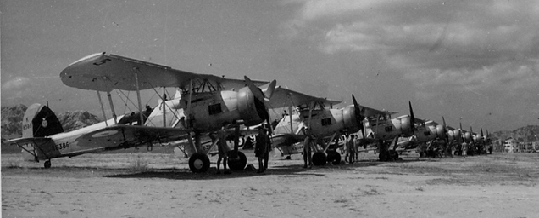 |
||
| 824 Sqn Swordfish at Seletar | ||
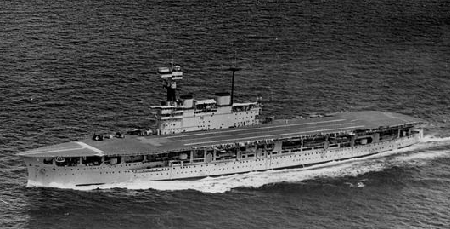 |
||
|
HMS Eagle on China Station 1937 - 1939 |
||
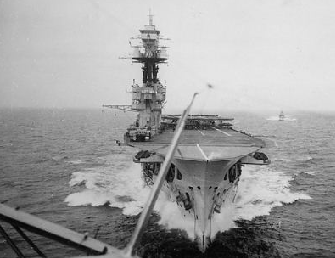 |
||
| HMS Eagle from the rear gunner position of a Swordfish | ||
 |
|
|
| No 824 Squadron aboard HMS Eagle | Hoisting a Swordfish aboard HMS Eagle | |
 |
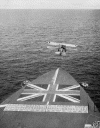 |
 |
| No 824 Sqn in front of Swordfish | Swordfish clearing the deck of HMS Eagle | Swordfish floatplanes of No 824 Squadron |
All above photos courtesy of Paul Cooper and are credited to his father E E (Ted) Cooper - LAC Fitter Airframes and Engines - RAF On Board HMS Eagle 1937 to 1939
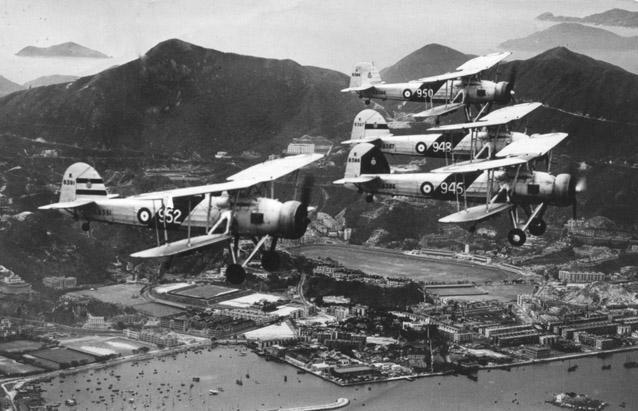 |
| 824 Squadron Swordfish from HMS
Eagle on Coronation Flypast over Hong Kong (Happy Valley racecourse in
background). Pilot of 945 with black flight leader's marking on tail is Sqn
Ldr A B Woodhall and crew is L/Tel Faulkner and Lt Gardner. Photo taken
0825, May 12, 1937. (photo courtesy of Martin Woodhall) |
[Aircraft & Markings | Commanding Officers]
This was formed on 8 October 1934 by renumbering No 824 Squadron on board HMS Eagle, which was serving on the China Station. In January 1935 the ship and the squadron moved to the Mediterranean, where in March the squadron disembarked at Hal Far when the carrier returned home for a refit. In September 1935 the squadron joined HMS Glorious, alternating between the ship and Hal Far for the remainder of its service in the RAF, except for a brief return to the UK to take part in the Coronation Review of May 1937. The Squadron was transferred to Admiralty control on 24 May 1939.
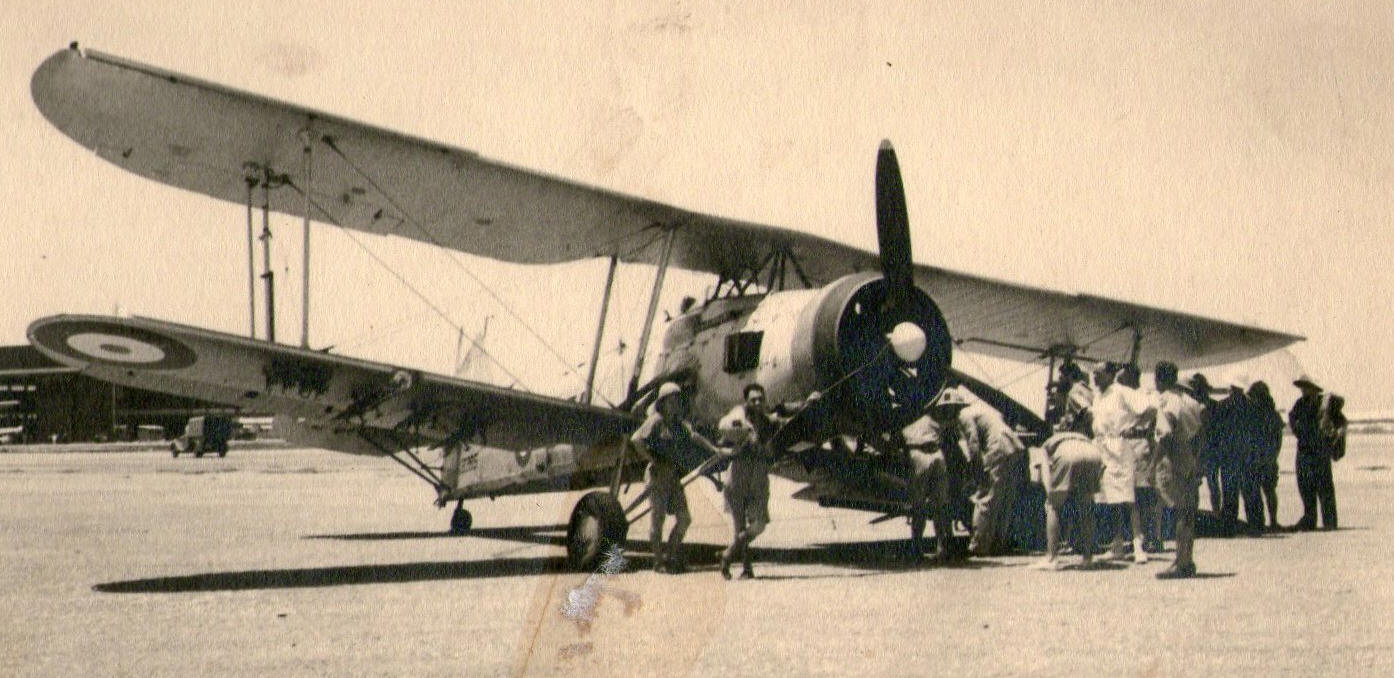 |
| This photo was taken or acquired
by Brian (Jock) Ewart who wrote on the back of it: - "Effect of a bad
landing. One of B flight 825 Sqn machines at D&R Leila ?- July 1939" |
[Aircraft & Markings | Commanding Officers]
This entry was last updated on 18/04/25©
![]() Organisational Index
Organisational Index ![]()